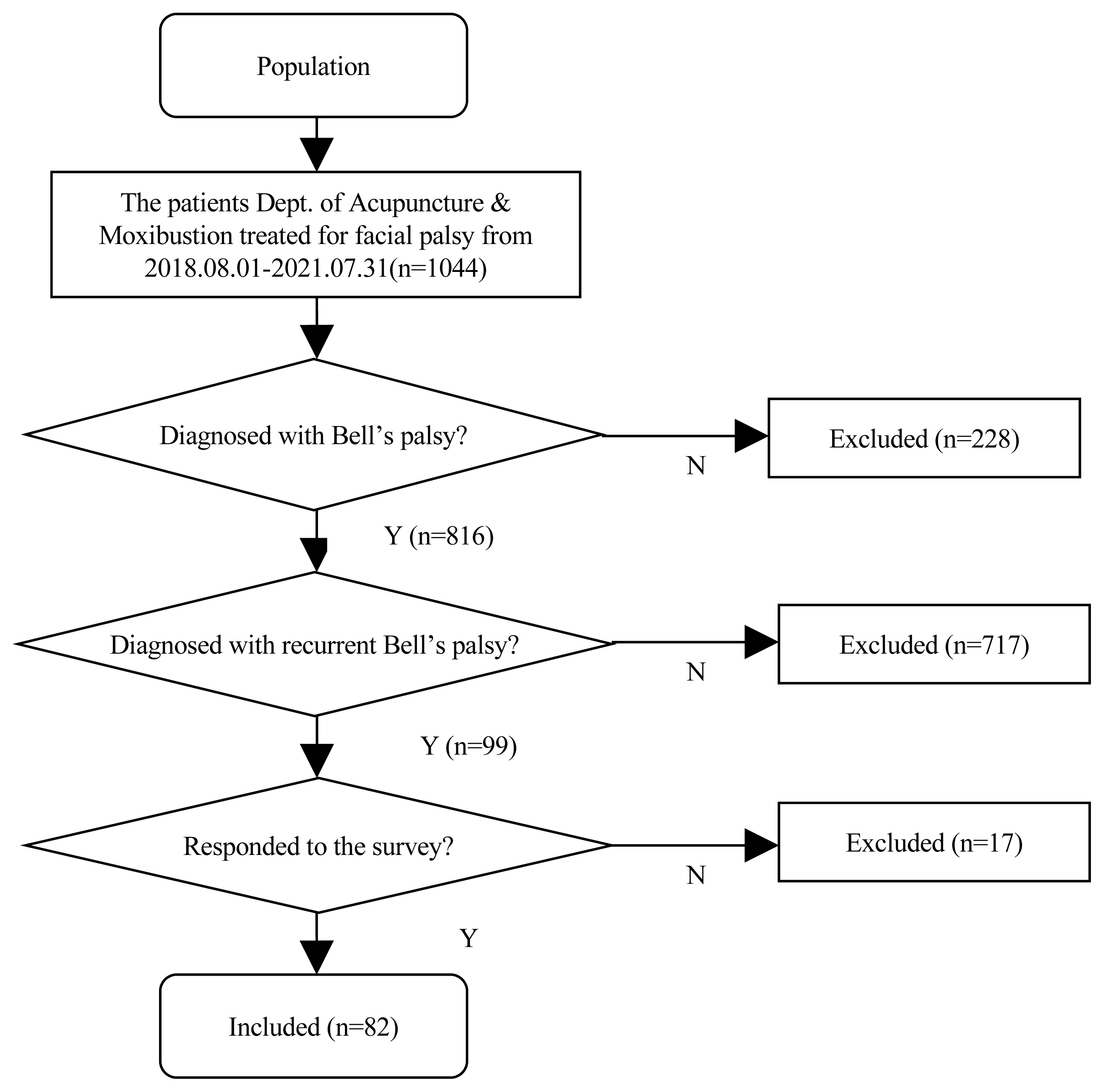References
1. Jung YS, Jang SY, Shin HCA. Clinical Study about General Characteristics . 2013;Treatment Progress and Obesity-underweight of Idiopathic Facial Paralysis (Bell’s palsy). Korean J Orient Int Med 34(1):86–99.
2. Kim J. 2020. Facial nerve and Facial Paralysis Seoul, Korea: Dhmbook. p. 43–44.
p. 74–83.
3. 한국한의학연구원. 2015. Idiopathic Facial Palsy Korean Medicine Clinical Practice Guideline Seoul, Korea: 엘스비어코리아(유).
4. Kang EK, Kim JH, Seo HS. 2009;The clinical investigation studies in peripheral facial paralysis using Needle-embedding therapy. J Korean Med Ophthalmol Otolaryngol Dermatol 22(2):118–27.
5. Lee ES, Jeong JY, Seo DG, Shin SY, Seo JC, Seo YJ, Jang KJ. 2014;Clinical research of cervical acupotomy effects with acupuncture on facial & trigeminal nerve branch on peripheral facial paralysis and postauricular pain. The Acupunct 31(4):143–54.
6. Jeong JY, Lee ES, Seo DG, Shin SY, Kim SY, Kwon HK, Yoon HM. 2014;The clinical research of cervical Chuna treatment’s effects on Bell’s palsy. The Acupunct 31(3):45–55.
7. Park YK, Lee CI, Lee JH, Lee HJ, Lee YK, Seo JC, Kim JS. 2019;A Facial Chuna Manual Therapy for Peripheral Facial Nerve Palsy. Journal of Acupuncture Research 36(4):197–203.
https://doi.org/10.13045/jar.2019.00283
.
9. KAMM. Acupuncture medicine Seoul, Korea: Hanmibook; 2016. p. 656–58.
11. Shin YJ, Kwon NH, Park HA, Woo HS, Beak YH, Park DS, Koh HK. 2009;Clinical Study on Recurrent Peripheral Facial Nerve Palsy. The journal of Korean Acupuncture & Moxibustion Society 26(1):29–37.
12. Lee HI, Shin JB, Lee SJ, Jun PS, Kim KT. 2005;Long-term Follow-up of Idiopathic Facial Palsy. Annals of Rehabilitation Medicine 29(6):602–607.
13. House JW, Brackmann DE. 1985;Facial nerve grading system. Otolaryngology--head and neck surgery: official journal of American Academy of Otolaryngology-Head and Neck Surgery 93(2):146–7.
doi:10.1177/019459988509300202.
15. Yoo MC, Soh YS, Chon JM, Lee JH, Jung JY, Kim SS, Yeo SG. 2020;Evaluation of actors associated with favorable outcomes in adults with Bell palsy. JAMA Otolaryngol Head Neck Surg 146:256–263.
https://doi.org/10.1001/jamaoto.2019.4312
.
16. Heckmann JG, Urban PP, Pitz S, Guntinas-Lichius O, Gágyor I. 2019;The diagnosis and treatment of idiopathic facial paresis (Bell’s palsy). Dtsch Arztebl Int 116:692–702.
https://doi.org/10.3238/arztebl.2019.0692
.
20. Kim JS, Kim JH, Kim YS, Koh HK, Kang SK, Kim CH. 2000;Cross-sectional Study on Recurrence of Bell’s Palsy. Journal of Acupuncture Research 17(3):69–74.
21. Huh SS, Kim YI. 2021;Review on Clinical Studies of Recurrent Facial Palsy Treatment in Republic of Korea. Journal of Haehwa Medicine 30(1):1–10.
22. Lee JW, Kwon SA, Kim MJ, Song JY, Kim PG, Seo BK, Baek YH. 2011;A Study of Facial Palsy Sequelae and Evaluating Scale. J Korean Acupunct Moxib Soc 28(2):75–87.
23. Kim KJ, Seok JI, Lee DK. 2008;The Clinical Analysis of Recurrent Bell’s Palsy. Annals of Clinical Neurophysiology 10(1):38–42.
24. Dourado GB, Volpato GH, Pedron Oltramari PV, De almeida-pedrin RR, Freire Femandes TM. De castro ferreire conti AC. 2021;Likert scale vs visual analog scale for assessing facial pleasantness. Am J Orthod Dentofacial Orthop 160(6):844–852.
https://doi.org/10.1016/j.ajodo.2020.05.024
.
25. Lee YR, Cha HJ, Choi HK, Kim MJ, Kim BS, Sung KJ, Kim YI. 2021;Analysis of Patients Visiting Department of Acupuncture and Moxibustion in Korean Medicine Hospital Before and After COVID-19 - Focusing on a Korean Medicine Hospital in Daejeon. Journal of Korean Medicine 42(2):31–49.
https://doi.org/10.13048/jkm.21013
.
26. Jeon SJ, Choi ES, Lee HY. 2010;Gender-related Difference in the Utilization of Health Care Services by Korean Adults. The Journal of Korea Community Health Nursing Academic Society 24(2):182–196.
https://doi.org/10.5932/JKPHN.2010.24.2.182
.
27. 대한이과학회. 2010. Seoul, Korea: 급성안면 신경마비 진료지침
28. Park GN, Jeong JK, Kim ES, Kim JH, Kim YI. 2017;Prognostic Factors of Idiopathic Facial Palsy: A Retrospective Study. Journal of Acupuncture Research 34:23–38.
https://doi.org/10.13045/acupunct.2017090
.















